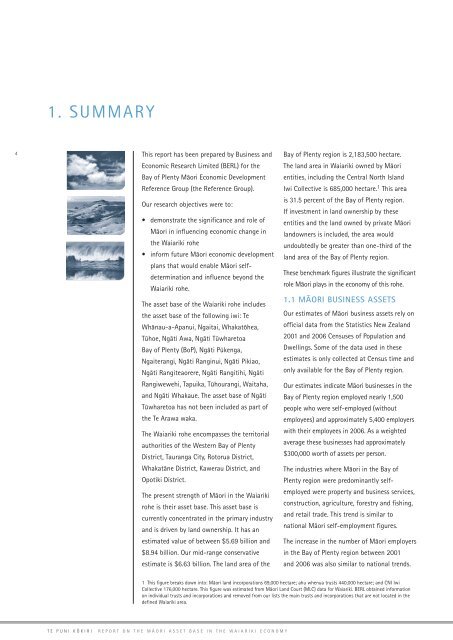Full Document: PDF 949KB - Te Puni Kokiri
Full Document: PDF 949KB - Te Puni Kokiri
Full Document: PDF 949KB - Te Puni Kokiri
Create successful ePaper yourself
Turn your PDF publications into a flip-book with our unique Google optimized e-Paper software.
1. SUMMARY<br />
4<br />
This report has been prepared by Business and<br />
Economic Research Limited (BERL) for the<br />
Bay of Plenty Mäori Economic Development<br />
Reference Group (the Reference Group).<br />
Our research objectives were to:<br />
• demonstrate the significance and role of<br />
Mäori in influencing economic change in<br />
the Waiariki rohe<br />
• inform future Mäori economic development<br />
plans that would enable Mäori selfdetermination<br />
and influence beyond the<br />
Waiariki rohe.<br />
The asset base of the Waiariki rohe includes<br />
the asset base of the following iwi: <strong>Te</strong><br />
Whänau-a-Apanui, Ngaitai, Whakatöhea,<br />
Tühoe, Ngäti Awa, Ngäti Tüwharetoa<br />
Bay of Plenty (BoP), Ngäti Pükenga,<br />
Ngaiterangi, Ngäti Ranginui, Ngäti Pikiao,<br />
Ngäti Rangiteaorere, Ngäti Rangitihi, Ngäti<br />
Rangiwewehi, Tapuika, Tühourangi, Waitaha,<br />
and Ngäti Whakaue. The asset base of Ngäti<br />
Tüwharetoa has not been included as part of<br />
the <strong>Te</strong> Arawa waka.<br />
The Waiariki rohe encompasses the territorial<br />
authorities of the Western Bay of Plenty<br />
District, Tauranga City, Rotorua District,<br />
Whakatäne District, Kawerau District, and<br />
Opotiki District.<br />
The present strength of Mäori in the Waiariki<br />
rohe is their asset base. This asset base is<br />
currently concentrated in the primary industry<br />
and is driven by land ownership. It has an<br />
estimated value of between $5.69 billion and<br />
$8.94 billion. Our mid-range conservative<br />
estimate is $6.63 billion. The land area of the<br />
Bay of Plenty region is 2,183,500 hectare.<br />
The land area in Waiariki owned by Mäori<br />
entities, including the Central North Island<br />
Iwi Collective is 685,000 hectare. 1 This area<br />
is 31.5 percent of the Bay of Plenty region.<br />
If investment in land ownership by these<br />
entities and the land owned by private Mäori<br />
landowners is included, the area would<br />
undoubtedly be greater than one-third of the<br />
land area of the Bay of Plenty region.<br />
These benchmark figures illustrate the significant<br />
role Mäori plays in the economy of this rohe.<br />
1.1 MÄORI BUSINESS ASSETS<br />
Our estimates of Mäori business assets rely on<br />
official data from the Statistics New Zealand<br />
2001 and 2006 Censuses of Population and<br />
Dwellings. Some of the data used in these<br />
estimates is only collected at Census time and<br />
only available for the Bay of Plenty region.<br />
Our estimates indicate Mäori businesses in the<br />
Bay of Plenty region employed nearly 1,500<br />
people who were self-employed (without<br />
employees) and approximately 5,400 employers<br />
with their employees in 2006. As a weighted<br />
average these businesses had approximately<br />
$300,000 worth of assets per person.<br />
The industries where Mäori in the Bay of<br />
Plenty region were predominantly selfemployed<br />
were property and business services,<br />
construction, agriculture, forestry and fishing,<br />
and retail trade. This trend is similar to<br />
national Mäori self-employment figures.<br />
The increase in the number of Mäori employers<br />
in the Bay of Plenty region between 2001<br />
and 2006 was also similar to national trends.<br />
1 This figure breaks down into: Mäori land incorporations 69,000 hectare; ahu whenua trusts 440,000 hectare; and CNI Iwi<br />
Collective 176,000 hectare. This figure was estimated from Mäori Land Court (MLC) data for Waiariki. BERL obtained information<br />
on individual trusts and incorporations and removed from our lists the main trusts and incorporations that are not located in the<br />
defined Waiariki area.<br />
TE PUNI KÖKIRI<br />
REPORT ON THE MÄORI ASSET BASE IN THE WAIARIKI ECONOMY

















